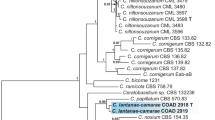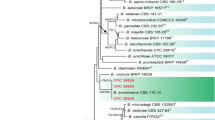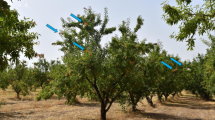Abstract
White thread blight is one of the most common diseases affecting several tree species that grow in warm and humid regions. The typical symptoms of this disease include blighted leaves hanging by a white thread of fungal hyphae. Leaf samples exhibiting white thread blight symptoms were collected from neem (Azadirachta indica A. Juss) and Brazilian cherry pitanga (Eugenia uniflora L.) plants in Northeastern Brazil, and from Indian green-tea (Camellia sinensis (L.) O. Kuntze), coffee (Coffea arabica L.), and persimmon (Diospyros kaki L.) in agricultural areas neighboring the Atlantic forest in Southeastern Brazil. Fungal isolates were obtained indirectly from leaf fragments or directly by transferring mycelia and sclerotia to culture medium. Bright field and scanning electron microscopy images revealed the association of Rhizoctonia-like hyphae and basidiospores with the infected leaves. In pathogenicity tests, Rhizoctonia-like fungal isolates induced leaf necrosis on their hosts, and the pathogens were re-isolated from inoculated plants. Phylogenetic analyses based on sequences of the ITS rRNA region indicated the occurrence of Ceratobasidium lineages distinct from previously reported Ceratobasidium species. Our study leads to the description of two new species of Ceratobasidium: the fungal isolates from A. indica, C. sinensis, and E. uniflora were classified as Ceratobasidium niltonsouzanum sp. nov., and those obtained from C. arabica and D. kaki as Ceratobasidium chavesanum sp. nov.






Similar content being viewed by others
References
Barreto RW, Evans HC, Ellison CA (1995) The mycobiota of the weed Lantana camara in Brazil, with particular reference to biological control. Mycological Research 99:769–782
Benchimol RL, Bastos CN (2004) Queima-do-fio em três espécies de plantas ornamentais. Comunicado Técnico, Embrapa, p 1–3
Benchimol RL, Poltronieri LS, Trindade DR, Albuquerque FC (2001) White-thread-blight: five new hosts in the state of Pará, Brazil. Fitopatologia Brasileira 26:778
Bozzola JJ, Russell LD (eds) (1999) Electron microscopy: principles and techniques for biologists, 2nd edn. Jones and Bartlett Publishers, Sudbury
Burt EA (1918) Corticiums causing Pellicularia koleroga disease of the coffee plant, Hypochnose of pomaceous fruits and Rhizoctonia disease. Annals of the Missouri Botanical Garden 5:5119–5132
Cavalcante MJB, Sales F (2001) Ocorrência da Queima-do-fio (Pellicularia koleroga) em cafezais em Rio Branco. Comunicado Técnico, Embrapa, p 1-2
Ceresini PC, Costa-Souza E, Zala M, Furtado EL, Souza NL (2012) Evidence that the Ceratobasidium-like white-thread blight and black rot fungal pathogens from persimmon and green-tea crops in the Brazilian Atlantic Forest agroecosystem are two distinct phylospecies. Genetics and Molecular Biology 35:480–497
Cooke MC (1876) Some Indian fungi. Grevillea 4:116–118
Costa RC, Verzignassi JR, Poltronieri TPS, Poltronieri LS, Monteiro LC (2013) Novos hospedeiros de Ceratobasidium ochroleucum, agente causal da queima-do-fio, no Pará. Summa Phytopathologica 39:62
Furtado E (1997) Doenças do chá. In: Kimati H, Amorim L, Bergamim Filho A, Camargo L and Rezende J (eds) Manual de Fitopatologia. 3rd edition. Agronômica Ceres, São Paulo, pp 257-260
Furtado EL (2005) Doenças do chá. In: Kimati H, Amorim L, Bergamim Filho A, Camargo L, Rezende J (eds) Manual de Fitopatologia, vol 2, 4th edn. Agronômica Ceres, São Paulo, pp 257–260
Garcia A, Veneziano W (1998) Queima do fio, mal de koleroga ou mal de hilachas (sinonimia: Pillicularia koleroga: Koleroga noxia donk= Corticium koleroga): Uma doença em expansão nos cafeeiros de Rondônia. Comunicado técnico, Embrapa, p 1-11
González Garcia V, Portal Onco MAP, Rubio Susan VR (2006) Review, biology and systematics of the form genus Rhizoctonia. Spanish Journal of Agricultural Research 4:55–79
Hepperle D (2004) SeqAssem Win32-version. A sequence analysis tool contig assembler and trace data visualization tool for molecular sequences. Available at http://www.sequentix.de
Kotiranta H, Saarenoksa R (2005) Ceratobasidium and Oliveonia (Basidiomycota, Aphyllophorales) in Finland. Annales Botanici Fennicci 42:237–245
Lourd M, Alves B (1987) Lista de hospedeiro e etiologia da queima-do-fio das plantas frutíferas na região Amazônica. Fitopatologia Brasileira 12:88–89
Lourd M, Alves MLB (1997) Lista de hospedeiros e etiologia da queima do fio das plantas frutíferas da região Amazônica. Fitopatologia Brasileira 12:88–89
Macedo DM, Pereira OL, Hora Junior BT, Weir BS, Barreto RW (2016) Mycobiota of the weed Tradescantia fluminensis in its native range in Brazil with particular references to classical biological control. Australasian Plant Pathology 45:45–56
Mendes MAS, da Silva VL, Dianese JC (1998) Fungos em Plantas no Brasil. Embrapa-SPI, Embrapa Cenargem. 555p
Miller MA, Pfeiffer W, Schwartz T (2010) Creating the CIPRES Science Gateway for inference of large phylogenetic trees. 1–8, in: Proceedings of the Gateway Computing Environments Workshop (GCE), 14 Nov. 2010, New Orleans, LA
Oberwinkler F, Riess K, Bauer R, Kirschner R, Garnica S (2013) Taxonomic re-evaluation of the Ceratobasidium-Rhizoctonia complex and Rhizoctonia butinii, a new species attacking sprume. Mycological Progress 12:763–776
Posada D, Buckley TR (2004) Model selection and model averaging in phylogenetics: advantages of Akaike information criterion and Bayesian approaches over likelihood ratio tests. Systematic Biology 53:793–808
Rambaut A (2009) FigTree 1.2.2. Available at: http://tree.bio.ed.ac.uk/software/figtree/. Accessed on October 20, 2015
Rogers DP (1935) Notes on lower basidiomycetes. University of Iowa Studies in Natural History 17:1–43
Ronquist F, Teslenko M, van der Mark P, Ayres DL, Darling A, Höhna S, Larget B, Liu L, Suchard AM, Huelsenbeck JP (2011) MrBayes 3.2: efficient Bayesian phylogenetic inference and model choice across a large model space. Systematic Biology 61:539–542
Sambrook J, Fritschi EF, Maniatis T (1989) Molecular cloning: a laboratory manual. Cold Spring Harbor Laboratory Press, New York
Sneh B, Burpee L, Ogosh A (1991) Identification of Rhizoctonia species. APS Press. St. Paul. 133p
Souza EC, Basseto MA, Boliani AC, Takada HM, Ceresini PC (2009) Patogenicidade cruzada de Ceratobasidium spp. do caquizeiro (Diospyros kaki) e do chá (Camellia sinensis) e reação de cultivares de caqui ao patógeno. Summa Phytopathologica 35:9–14
Tamura K, Stecher G, Peterson D, Filipski A, Kumar S (2013) MEGA6: molecular evolutionary genetics analysis version 6.0. Molecular Biology and Evolution 30:2725–2729
Thompson JD, Higgins DG, Gibson TJ (1994) CLUSTAL W: improving the sensitivity of progressive multiple sequence alignment through sequence weighting, position-specific gap penalties and weight matrix choice. Nucleic Acids Research 22:4673–4680
Venkatarayan S (1949) The validity of the name Pellicularia koleroga Cooke. Indian Phytopathology 2:186–189
Von Hoehnel, F (1910) Fragments Zur Mykologie. X. Sitzungber. K. Akad. Wiss. Wien, Math-Natur. Wiss. Klass. 199. 395, 1910
White TJ, BrunsT, Lee S, Taylor JW (1990) Amplification and direct sequencing of fungal ribosomal RNA genes for phylogenetics. In: Innis MA, Gelfand DH, Sninsky JJ, White TJ (eds) PCR protocols: a guide to methods and applications. New York, USA. Academic Press, pp 315–322
Wolf F, Bach WJ (1927) The thread blight disease caused by Corticium koleroga (Cooke) Hohn., on citrus and pomaceus plants. Phytopathology 17:689–707
Acknowledgements
The authors thank Coordenação de Aperfeiçoamento de Pessoal de Nível Superior (CAPES)/Programa Nacional de Pós-Doutorado (PNPD) for granting post-doctoral fellowship to MPM, KSM and SIM. This study was supported by Conselho Nacional de Desenvolvimento Científico e Tecnológico (CNPq), Fundação de Amparo a Pesquisa de Minas Gerais (FAPEMIG) and Fundação de Amparo a Pesquisa do Estado de São Paulo (FAPESP, grant number 04/1980-0 to PCC).
Author information
Authors and Affiliations
Corresponding author
Additional information
Section Editor: Simon Shamoun
Rights and permissions
About this article
Cite this article
de Melo, M.P., Matos, K.S., Moreira, S.I. et al. Two new Ceratobasidium species causing white thread blight on tropical plants in Brazil. Trop. plant pathol. 43, 559–571 (2018). https://doi.org/10.1007/s40858-018-0237-x
Received:
Accepted:
Published:
Issue Date:
DOI: https://doi.org/10.1007/s40858-018-0237-x




